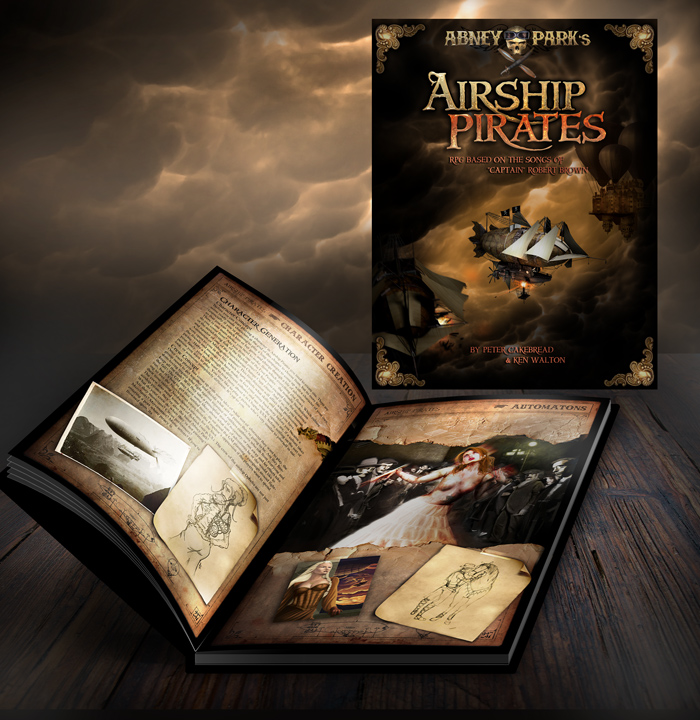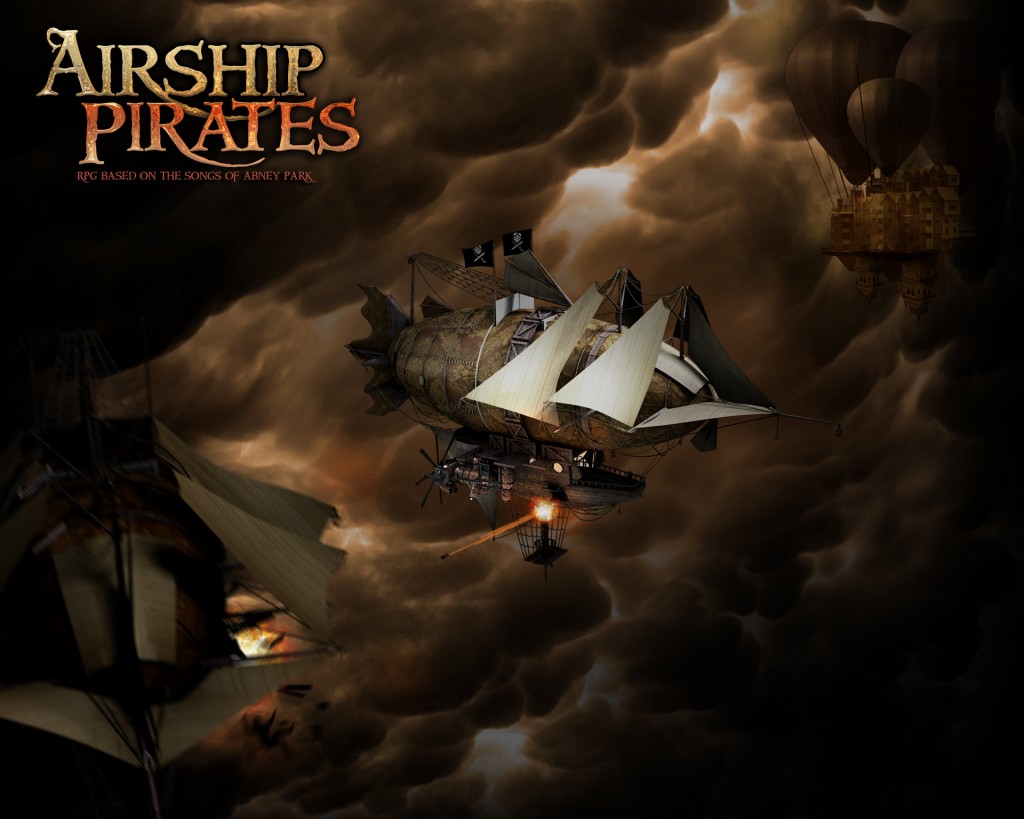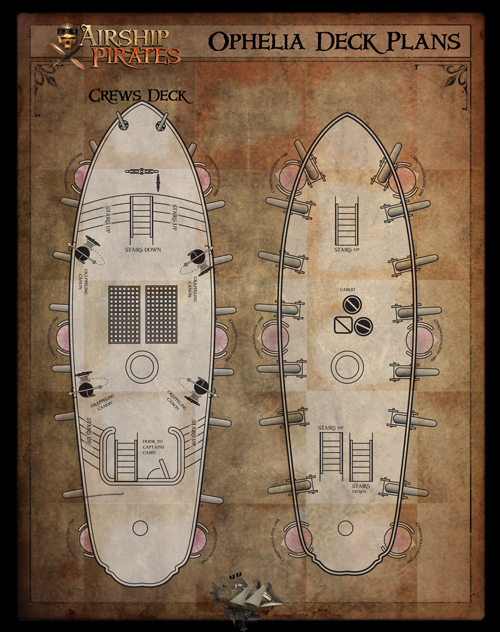Avast! Ye Scurvy Post-apocalyptic, Time-skipping, Brass-fancier! — Reviewing Abney Park’s Airship Pirates
First Look
Airship Pirates is a game of flying post-apocalyptic steampunk based on the music of the “quintessential steampunk band,” Abney Park. The game casts the player-characters as pirates plying the skies above a harsh wasteland in an Age-of-Sail-inspired airship. Like all games published by Cubicle 7 Entertainment, it boasts excellent production value: a good solid hardcover with heavy paper and evocative colorful art by a variety of artists throughout (I particularly liked Phantoms Siren’s work).
The game is broken into three “books” plus a detailed table of contents, a small index, an handsome character sheet, a few maps, deck plans of a common airship, two pieces of gaming fiction, and the lyrics of Abney Park scattered throughout. Here, decidedly out-of-order, follows a breakdown of Airship Pirates:
Encyclopaedia (setting)
Chapter 1 covers the alternative history that gave rise to the world of Airship Pirates. Beginning with an errant time machine in 1906, we’re given a brief overview of over two hundred years of slightly improbably (and a bit naïve and fashionably anti-European) history culminating in a world thrown back into primeval wilderness by an evil dictator. A handful of cities dot the earth, colossal walled Victorian-themed factories. Nomads brave the predator-filled wastes. And carefree pirates sail above it all.
Next up is a tour of the geography of the default setting, namely North America. From the Arctic Circle to the jungles and swamps of the Everglades, this chapter showcases the prehistoric beasties to be found as well as the different cultures of the game and how they relate to their environment (and to each other).
Chapter 3 is an in-depth look at the setting’s major cultures. First up are the Skyfolk in their floating cities, the Skylofts, the mostly likely urban setting for the game. These fiercely independent cites are a hodgepodge of different governments, religions, and organizational skills, but they all share a love of (mad) science, a close relationship with pirates, and uneasy truce with the hated Imperial Air Navy. The chapter includes not just a discussion of the cities’ politics, economics, and power, but step-by-step instruction for creating Skylofts, including lots of useful random tables. The section ends with two very different sample cities and a helpful, if oddly placed, look at the Pirate Code.
While the Skyfolk have chosen to live above the weed-chocked ruins of the world, the next culture has chosen to live amongst them. Earth-bound survivors of the apocalypse, the different tribes of the Neobedouins wander the wilderness of North America, domesticating fearsome beasts, scavenging old-world technology, and trading raw materials and food to Skyfolk for manufactured goods. This section includes lots of good information on the Neobedouins, their shamanistic nature-religion, their uncanny relationship to animals, and their particular enemy, the Chuno Ggun – the Emperor’s elite marines. A sample tribe, the Western Camelops, is also presented. It is a good write-up but I would have like a little more information on what constitutes a tribe, whether blood, religion, politics, or something else. Perhaps in future supplements . . .
The setting’s last culture is the Neovictorians and it must be said that this steampunk game doesn’t seem to like them very much (nor the actual Victorians, but that is a rant for another time). They are the victims/villains of the game, the vast majority of them living in a half-dozen dreadful megacities, each built around a gigantic and mysterious prison for innovation called a Change Cage. These “Change Cage cities” are places of loving-detailed and almost comic faux-Victorian squalor. (The book spends 20 pages describing these cities, more than on either the Skyfolk of the Neobedouins, which seems odd since I can’t imagine much adventuring happening inside these horrid and stifling places.) There is explicit information on the cities’ administration (unfeeling), food (vegan glop), workhouse & factories (appalling), trade (cheap trinkets or smuggled goods), vices (gin-shops and robot-staffed brothels), propaganda (ubiquitous), and law-enforcement (draconian). There is also a note on the setting’s rather confusing level of technology and a page or so on the pirate-hunting Imperial Air Navy, the primary villains of the game. The Neovictorians themselves are comprised of 4 “subcultures” that Neovictorian players may chose from: Lower Class, Upper Class, the Misbegotten, and Automata. The Lower Class is – as one would expect – poor, dirty, and helpless. The Upper Class is also what one would expect: rich, privileged, well-educated, but still trapped in the gilded misery of the cities. The Misbegotten are an even lower class of mutants many of which – in grand SF/F tradition – have significant system advantages over non-mutant. The Automata are “no-class” clockwork and steam-powered servants who – in a neat twist – must pretend that they are non-sentient to escape dismantling. Like the previous sections, this one ends with a sample Change Cage city. Finally we have another sample town — Helium City, the independent Casablanca of the setting.
Rules and Systems
This book starts with a quick explanation of the basic system: a dice pool made of the appropriate skill + attribute is used for almost all situations. Every die that comes up with a “1” or a “6” is a success. Every “6” is rolled again in attempt to garner even more successes. More successes equal a bigger success while no successes is, of course, a failure. In dire situations the GM may impose black dice. Any success on a black die subtract a success form a normal die. Simple.
Armed with an understanding of the basic system, it is time to create a character. First players chose a culture and a prior life for their pirate. Each culture (or sub-culture) imparts bonuses or – if you’re a Neovictorian – penalties to attributes.
Characters have 6 attributes (Strength, Dexterity, Fortitude, Presence, Wits, & Resolve), and a handful of skill (which get their own chapter) and talents (special advantages), all which are purchased with Character Points. Complications (character flaws and disadvantages) can also be taken to earn more Character Points. Characters also have 2 derived attributes — Initiative and Movement – which are calculated from the 6 attributes. Lastly, each player receives 8 Fate Points that may be used to better the odds in dramatic moments.
After each player makes a character, the players as a group create a pirate crew starting with a crew concept, including its history, motivation, modus operandi, and schtick. Like individual characters, airships – and their crews – are build with a pool of points. Crews are rated 1-20 and are treated as a single entity while a whole chapter is devoted to airships and their customization. The chapter ends with 6 nicely fleshed-out sample characters.
Combat in Airship Pirates is simple but interesting. Both combatants make the same roll (dex + weapon skill) with the winner inflicting an amount of damage based on the margin of success. There is, of course, a range of modifiers: +1 die for winning initiative; -2 dice for an unreadied weapon; and +3 black dice per opponent for being outnumbered. To encourage awesomeness despite these penalties there is the “Awesome! Bonus”, extra dice awarded by GM for awesome combat maneuvers. Despite the obligatory rules for peg-legs and hook-hands, healing is generous and cinematic. Continuing a helpful trend, the chapter concludes with an example of combat.
After a short chapter of miscellaneous rules – such as drowning, drinking, and experience points – there is a chapter on airships and other modes of transportation. There are rules explaining how crews fight and heal, how vehicles chase one another and trade blows, and the unique idiosyncrasies of airships.
The Equipment Chapter includes a list of mostly standard stuff (clothes, goggles, grog) but also some nifty stuff – Difference Engines, Autophrenometers (machines that IDs people by reading the bumps on their heads), and talking pocket watches. The most common airships & other vehicles are given stats. Cargo, repair, and fuel costs are given. And there are of course weapons including cutlasses, quarterstaffs, and blunderbusses, but also “steam-thrower”, lightening gun, and the very popular steampistol.
Game Master
The last “book” in Airship Pirates begins with a chapter full of advice on running the game. There are some thoughts on role of the Game Master and adventure design (both structured and free-form). There are tips for brainstorming and seeking inspiration (particularly from songs of Abney Park) and an examination of the themes of the game: steampunk, freedom, post-apocalypse, pirates, and time travel.
Speaking of time travel, the next chapter gives us the “Golden Rules of Time Travel”: 1) It’s uncommon – only 2 time traveling devices exist, 1 for the NPCs, 1 for the PCs. 2) It’s hard – operating the device causes a almost sanity-draining fear (best countered with rum!). 3) It’s infrequent – for reasons unknown, the device is synchronized to the sun rather than the earth. This means that unless they travel in multiple of exactly one year the PCs will find themselves in space (mean GMs could point out that the calendar’s likely to have changed in 200 years)! 3) Screwing up the timeline is hard – time is somewhat self-correcting (but see below). 4) There is only one timeline – no multiple dimensions here! 5) A time traveler’s personal history is unchangeable (sort of). After these rules there are details on the mechanics of time travel as well as the inevitable exceptions to the rules, including a nice random table for screwing up the timeline.
A bestiary follows, with over 2 dozen animals (food, burden, predator) from Horses (why do “monster” lists always include horses, do we really need stats for horse? As the book itself says, “A horse is a horse. Of course”) to Giant Sloth to Shrub Ox.
And lastly, of course, there is a sample adventure, “The Tribulations of Scabby Jack”, a decent, straightforward adventure with scurvy NPCs, a few twists, and some good advice on adapting to changing events.
Final Thoughts
Airship Pirates is an enjoyable game with solid mechanics, suitable for new and experience players alike. The setting is imaginative and exciting, though not quite my cup of tea; I found it a tab convoluted and the treatment of the Neovictorians rather harsh and not as interesting as it could have been (if, for instance, the cities were not so awful then the pirates’ rebellion might be more meaningful). Time travel as well, while nicely done, seemed a bit tacked-on and unsupported (perhaps future supplements will remedy this). Nevertheless, if one overlooks these quibbles (or does not share them), Airship Pirates provides the perfect excuse to “hoist the black flag begin slitting throats”!






